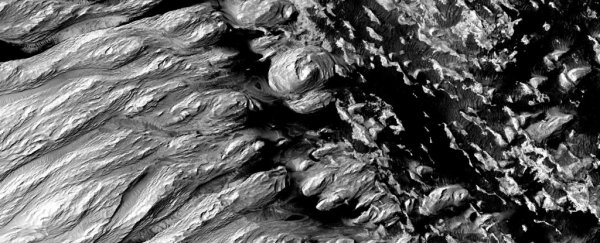Conditions on Mars are not forgiving. Just ask the Opportunity rover. Oh, you can't. It's been forced into a drastic hibernation by deadly dust storms so intense they've engulfed the entire planet.
During the intrepid explorer's shutdown, scientists announced the discovery of something amazing: a massive water lake hidden under the Martian ice. But across the surface, everything is dirty, dry, and covered in layers of this never-ending dust – and now we finally know where it all comes from.
Mars is a rocky place. On Earth, dust is lifted from rock by natural forces of erosion, such as the movement of wind, streams of water, volcanic activity, and the movement of glaciers.
But on Mars, things like water and glacial activity are at a minimum, and other phenomena that could separate particles of rock – such as meteorite impacts – would create coarser fragments, not the fine powder that's choking Opportunity as we speak.
"How does Mars make so much dust," asks planetary scientist Lujendra Ojha from Johns Hopkins University, "because none of these processes are active on Mars?"
We now have our answer.
A new analysis by Ojha and fellow researchers reveals that a mysterious geological region on the Red Planet is what's behind this churning mass of dust.
How much dust? It's an estimated 3 trillion kilograms displaced between the surface and atmosphere of Mars each year.
That's a lot of dust, and the team think almost all of it stems from the mysterious Medusae Fossae Formation, a deposit the ESA once described as "an extensive unit of enigmatic origin".
Enigmatic, yes, and seemingly not long for this world (or Mars, more to the point).
"Mars wouldn't be nearly this dusty if it wasn't for this one enormous deposit that is gradually eroding over time and polluting the planet," says one of the team, planetary geophysicist Kevin Lewis.
NASA discovered the 1,000-kilometre-long (about 620 miles) geological formation back in the 1960s, but it was only much more recently that scientists learned the feature is of volcanic origin – which means that it's the largest known volcanic deposit in our entire Solar System.
Even more amazingly, the Medusae Fossae Formation used to be much, much bigger, but its lightweight, porous composition – vulnerable to erosion over billions of years – means this Medusa is a ghost of her former self.
The team identified the formation as the dust culprit by matching the chemical composition of Martian dust to readings of the Medusae Fossae Formation taken by the NASA spacecraft Mars Odyssey.
"Dust everywhere on the planet is enriched in sulfur and chlorine and it has this very distinct sulfur-to-chlorine ratio," Ojha explains.
It turns out that tell-tale chemical signature is shared by the MFF, which scientists think was once as large as approximately 50 percent of the area of the United States.
These days, it's only about 20 percent – like we said at the top, conditions on Mars are not forgiving.
According to the team's calculations, that epic reduction of volcanic rock over the course of about 3 billion years would equate to a thick global layer of Martian dust, coating the Red Planet's surface in a dust deluge that's between 2 to 12 metres (about 7 to 40 ft) thick.
Earth has its own pollution problems, of course, but when it comes to dust, the Red Planet takes the cake.
The findings are reported in Nature Communications.
